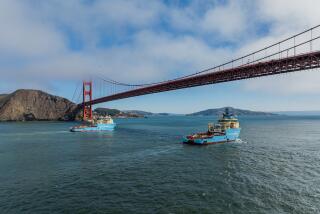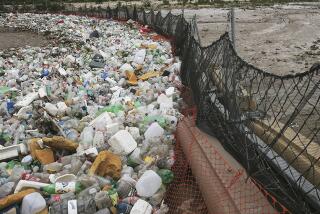Officials Seek to Polish Sydney’s Image : Pollution: Plan to clean beaches along Australia’s most populous city will cost $7.8 billion over 20 years. But critics say it doesn’t do enough.
SYDNEY, Australia — Sydney’s polluted beaches soon will be gleaming white and sparkling blue again, the government says. The state premier even went wading to prove it.
Most of Australia’s thousands of miles of shoreline resembles a postcard picture of white sand and crystal-clear surf. But Sydney’s waters have been fouled by outdated sewage-treatment facilities and century-old storm drains.
Things are getting better, but not fast enough for critics. They say new disposal pipelines merely push the sewage and toxic waste farther out, where it will destroy vital seabed growths.
Last year, the New South Wales state government and Sydney area water board opened the first of the three lines that carry wastes more than a mile beyond shore. The lines cost $235 million to build.
In January, the state announced an additional $300 million program that will phase out storm drains at many beaches, close some incinerators and provide new technology for sewage treatment.
All this is part of the water board’s 20-year, $7.8 billion-plan to improve the sewage system of Australia’s largest city, where 3 million people live.
The first reports of “horrible sewage-loaded sea” appeared in Daily Telegraph Pictorial in 1929. Accompanying the story was a photograph of a plume of raw sewage.
More recently, primary treatment of sewage near two of Australia’s most famous beaches--Manly and Bondi--afflicted surfers and swimmers with infections caused by fecal matter.
Protest groups were formed. One, with Australian directness, used an applicable, unprintable acronym.
“It’s no secret that many beachgoers have stayed away in recent seasons because Bondi Beach had an unwelcome reputation for being polluted,” said Joe Schipp, the state housing minister.
But, he added, “The water at Australia’s most famous beach will soon be bright blue again.”
Schipp is responsible for the water board.
When state Premier Nick Greiner opened the Bondi waste pipeline in mid-August, he waded barefoot in clean surf to accent the point that the water is cleaner. A year ago, surfers at Bondi complained of floating debris that included condoms, sanitary napkins and fecal matter.
Some anti-pollution groups say the government’s plans are inadequate.
Richard Gosden of Stop the Ocean Pollution, or STOP, interrupted Greiner’s speech at the pipeline opening to argue that pumping sewage farther out to sea only relocates the problem.
“The extended outfalls were designed to hide the sewage from view, not treat it or prevent toxic pollution of the marine environment,” he said. “The Water Board has done little to prevent industry putting toxic waste into the sewers.”
But Water Board officials announced in June that $15.6 million will be invested in the prototype of a revolutionary filtration plant at Cronulla in south Sydney.
It will use a filtration system which strips organic materials and microbes from treated sewage faster and more efficiently than existing methods.
Fishermen are already pleased. They say the water is cleaner and fish more plentiful.
“Everyone on our side thinks it’s a very positive move and a great thing for the industry,” said restaurateur Peter Doyle, a member of the state Fish Marketing Authority.
More to Read
Sign up for Essential California
The most important California stories and recommendations in your inbox every morning.
You may occasionally receive promotional content from the Los Angeles Times.









